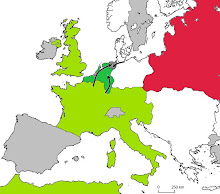 September 1944 saw the continuation of the Russian advance in the northern sector of the front. On the 4th, Vasilevsky led a huge Soviet formation against Riga, which held out for less than five days. Then his army swept west to the Baltic coast, while a substantial portion, led by armoured units, charged south, reaching the Vistula as early as the 20th.
September 1944 saw the continuation of the Russian advance in the northern sector of the front. On the 4th, Vasilevsky led a huge Soviet formation against Riga, which held out for less than five days. Then his army swept west to the Baltic coast, while a substantial portion, led by armoured units, charged south, reaching the Vistula as early as the 20th.A key factor in this advance was the Russian air force. German reserves were slow to react, harassed daily from the air and this prevented Field Marshall Model from transferring the much needed divisions from the quieter southern sector of the front.
While Vasilevsky was making good gains in the north, Zhukov’s forces were making their attack on Vilnius. Success here would see the German forces in Latvia hopelessly surrounded, and a link up with an attack on Pinsk in the south would liberate all of Byelorussia and reach the border with Poland.
Initially the Russian commander faced some grim resistance, with German forces, led by the formidable Jagdpanzers and highly trained and motivated units from the Fallschirmjaeger, launched a series of aggressive counter attacks which badly mauled the Russian tank formations. However the brave attacks of a few units were to no avail. So overwhelming were the forces arrayed against army group centre, that reserves simply replaced the losses incurred by the Russians.
By the end of September the Russians had linked up with each other on the banks of the Vistula, having taken the Baltic states and Byelorussia. Stalin was pleased with his gains and now had to make a decision. Continue the lightning advance in the east while the western allies floundered in the south, or pause to spread the seed of communism elsewhere before the war ended.

No comments:
Post a Comment